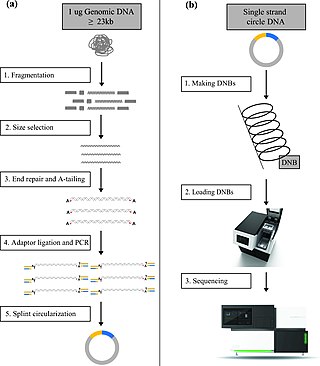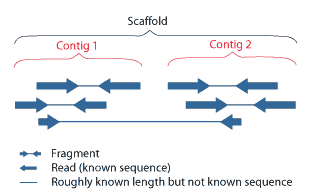History
Pacific Biosciences (PacBio) commercialized SMRT sequencing in 2011, [11] after releasing a beta version of its RS instrument in late 2010. [12]
RS and RS II
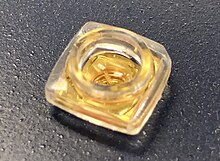
At commercialization, read length had a normal distribution with a mean of about 1100 bases. A new chemistry kit released in early 2012 increased the sequencer's read length; an early customer of the chemistry cited mean read lengths of 2500 to 2900 bases. [13]
The XL chemistry kit released in late 2012 increased average read length to more than 4300 bases. [14] [15]
On August 21, 2013, PacBio released a new DNA polymerase Binding Kit P4. This P4 enzyme has average read lengths of more than 4,300 bases when paired with the C2 sequencing chemistry and more than 5,000 bases when paired with the XL chemistry. [16] The enzyme’s accuracy is similar to C2, reaching QV50 between 30X and 40X coverage. The resulting P4 attributes provided higher-quality assemblies using fewer SMRT Cells and with improved variant calling. [16] When coupled with input DNA size selection (using an electrophoresis instrument such as BluePippin) yields average read length over 7 kilobases. [17]
On October 3, 2013, PacBio released new reagent combination for PacBio RS II, the P5 DNA polymerase with C3 chemistry (P5-C3). Together, they extend sequencing read lengths to an average of approximately 8,500 bases, with the longest reads exceeding 30,000 bases. [18] Throughput per SMRT cell is around 500 million bases demonstrated by sequencing results from the CHM1 cell line. [19]
On October 15, 2014, PacBio announced the release of new chemistry P6-C4 for the RS II system, which represents the company's 6th generation of polymerase and 4th generation chemistry--further extending the average read length to 10,000 - 15,000 bases, with the longest reads exceeding 40,000 bases. The throughput with the new chemistry was estimated between 500 million to 1 billion bases per SMRT Cell, depending on the sample being sequenced. [20] [21] This was the final version of chemistry released for the RS instrument.
Throughput per experiment for the technology is both influenced by the read length of DNA molecules sequenced as well as total multiplex of a SMRT Cell. The prototype of the SMRT Cell contained about 3000 ZMW holes that allowed parallelized DNA sequencing. At commercialization, the SMRT Cells were each patterned with 150,000 ZMW holes that were read in two sets of 75,000. [22] In April 2013, the company released a new version of the sequencer called the "PacBio RS II" that uses all 150,000 ZMW holes concurrently, doubling the throughput per experiment. [23] [24] The highest throughput mode in November 2013 used P5 binding, C3 chemistry, BluePippin size selection, and a PacBio RS II officially yielded 350 million bases per SMRT Cell though a human de novo data set released with the chemistry averaging 500 million bases per SMRT Cell. Throughput varies based on the type of sample being sequenced. [25] With the introduction of P6-C4 chemistry typical throughput per SMRT Cell increased to 500 million bases to 1 billion bases.
| C1 | C2 | P4-XL | P5-C3 | P6-C4 | |
|---|---|---|---|---|---|
| Average read length bases | 1100 | 2500 - 2900 | 4300 - 5000 | 8500 | 10,000 - 15,000 |
| Throughput per SMRT Cell | 30M - 40M | 60M - 100M | 250M - 300M | 350M - 500M | 500M - 1B |
Sequel
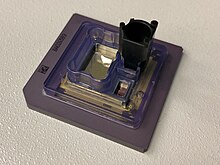
In September 2015, the company announced the launch of a new sequencing instrument, the Sequel System, that increased capacity to 1 million ZMW holes. [26] [27]
With the Sequel instrument initial read lengths were comparable to the RS, then later chemistry releases increased read length.
On January 23, 2017, the V2 chemistry was released. It increased average read lengths to between 10,000 and 18,000 bases. [28]
On March 8, 2018, the 2.1 chemistry was released. It increased average read length to 20,000 bases and half of all reads above 30,000 bases in length. Yield per SMRT Cell increased to 10 or 20 billion bases, for either large-insert libraries or shorter-insert (e.g. amplicon) libraries respectively. [29]
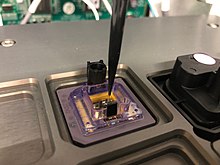
On 19 September 2018, the company announced the Sequel 6.0 chemistry with average read lengths increased to 100,000 bases for shorter-insert libraries and 30,000 for longer-insert libraries. SMRT Cell yield increased up to 50 billion bases for shorter-insert libraries. [10]
| V2 | 2.1 | 6.0 | |
|---|---|---|---|
| Average read length bases | 10,000 - 18,000 | 20,000 - 30,000 | 30,000 - 100,000 |
| Throughput per SMRT Cell | 5B - 8B | 10B - 20B | 20B - 50B |
8M Chip
In April 2019 the company released a new SMRT Cell with eight million ZMWs, [30] increasing the expected throughput per SMRT Cell by a factor of eight. [31] Early access customers in March 2019 reported throughput over 58 customer run cells of 250 GB of raw yield per cell with templates about 15 kb in length, and 67.4 GB yield per cell with templates in higher weight molecules. [32] System performance is now reported in either high-molecular-weight continuous long reads or in pre-corrected HiFi (also known as Circular Consensus Sequence (CCS)) reads. For high-molecular-weight reads roughly half of all reads are longer than 50 kb in length.
| Early Access | 1.0 | 2.0 | |
|---|---|---|---|
| Throughput per SMRT Cell | ~67.4 GB | Up to 160 GB | Up to 200 GB |
The HiFi performance includes corrected bases with quality above Phred score Q20, using repeated amplicon passes for correction. These take amplicons up to 20kb in length.
| Early Access | 1.0 | 2.0 | |
|---|---|---|---|
| Raw reads per SMRT Cell | ~250 GB | Up to 360 GB | Up to 500 GB |
| Corrected reads per SMRT Cell (>Q20) | ~25 GB | Up to 36 GB | Up to 50 GB |







